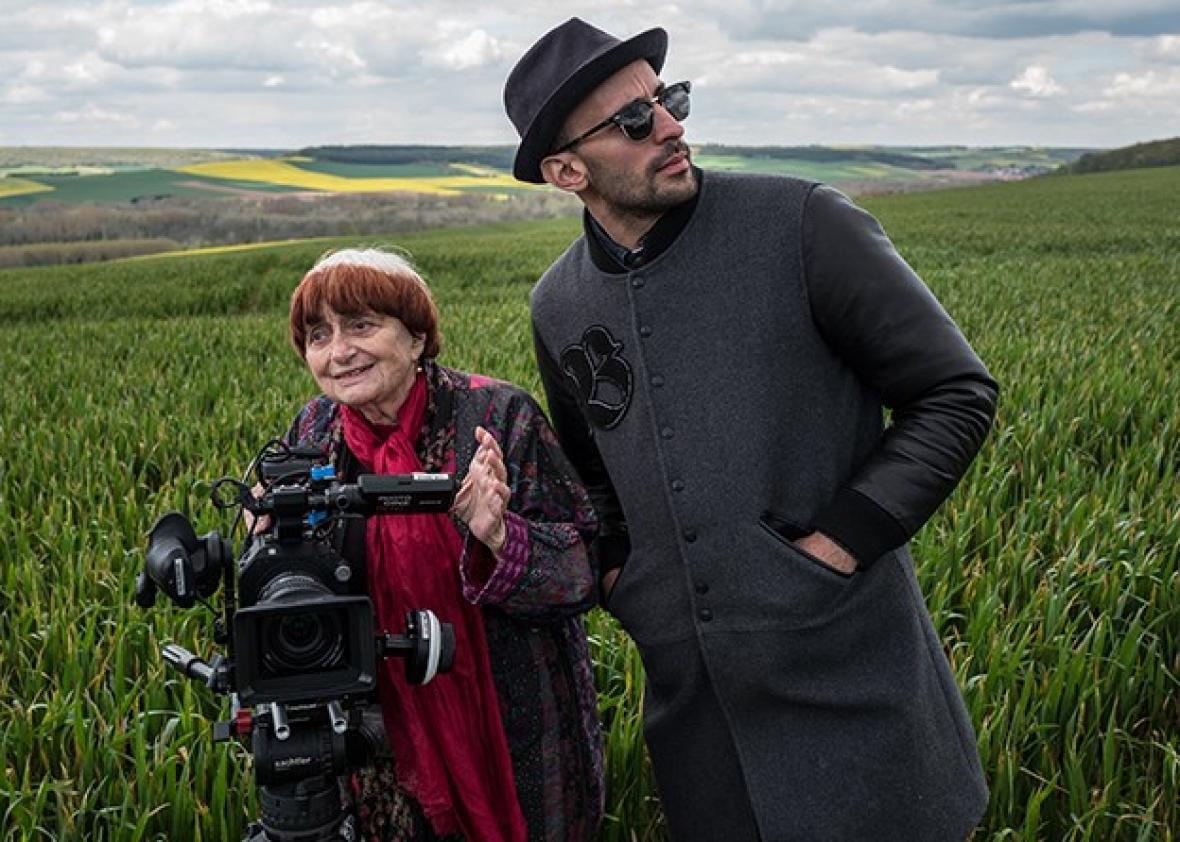Flaubert wrote that the artist should be like God in his work, existing everywhere and yet never seen—but Agnès Varda doesn’t want to be God. In the movies she’s made since 2000, beginning with The Gleaners and I, Varda, who was given the motion picture academy’s Governor’s Award over the weekend, is a constant presence even when she’s not in front of the camera. Especially in her documentaries, every image, every cut, feels like the product of a single personality, and after you’ve seen enough of them, watching a new Varda film is like catching up with an old friend.
In Varda’s latest, and possibly last film, Faces Places, that old friend shows up with a new associate in tow: J.R., a now-34-year-old photographer and street artist who is sometimes called the French Banksy. And he’s not just along for the ride. The movie, which credits Varda and J.R. as co-directors, follows their joint project to travel through the French countryside, taking black-and-white photos of its residents and pasting their super-sized enlargements on apartment buildings and barns. The method is J.R.’s—in September, he did the same with a photograph of a Mexican baby so that it seemed to be about to crawl over the border fence—and if you’ve come for a continuation of Varda’s mercurial oeuvre, J.R.’s self-conscious statements can be an unwanted intrusion. But Varda, whose own movies have paid special attention to the overlooked and dispossessed, clearly sees something in J.R., and so you do, too.
There’s another, more practical reason Varda shares the director’s credit. As Faces Places reveals, her eyesight has deteriorated to the point that she can only see the world as a vague blur. The camera, which in Gleaners came to seem like an extension of her own body, is now held by other hands. It’s gutting to realize that you’re watching what may be the last film (half-)made by one of the 20th century’s greatest filmmakers, but there’s nothing ponderous or funereal about the movie itself. Varda clearly feels the deaths of those she has loved deeply; in Faces Places she makes a point of visiting her old friend Henri Cartier-Bresson, and she has been mourning her late husband Jacques Demy in one form or another since his death in 1990. (She brought a photo of Demy with her to the Governor’s Awards, and “tucked it in” using a napkin as a makeshift blanket.) But she has gone beyond the point where it is something that she fears for herself. “I’m looking forward to it,” she says at one point, “because then that’ll be that.”
Although her vision may be failing, Varda’s mind is as sharp as ever, and her spirit as beguiling. Like her pre-New Wave compatriot Chris Marker, she makes films that don’t feel constructed so much as they do thought, beamed straight from her consciousness onto the screen. When she snaps at J.R. that he’s disrupted her train of thought, the movie gets derailed too, as if it’s standing in a room and trying to remember what it came in for. Faces Places has a more solid, conventional structure than some of Varda’s more associative documentaries; it’s a road movie, following a trail that eventually leads to her old friend Jean-Luc Godard’s front door. But she’s in no hurry to get where she’s going, keeping her eyes, however blurry, open to possibilities along the way. “Chance,” she says, “has always been my best assistant.”
Varda and J.R. are congenial companions for the most part, traveling in a truck made up to look like an old still-photo camera. But she bristles at his self-created mystique, especially his insistence on wearing sunglasses no matter the circumstances. In a film devoted to focusing on the human face, J.R.’s is conspicuous in its elusiveness, and Varda’s patience with his affectation runs thin—or at least it seems to. Perhaps it’s the archness of J.R.’s presence, but there are more moments in Faces Places that feel like they might be staged, or at least provided for in advance, than in Varda’s previous documentaries. She admits on camera that the idea to seek out Godard is an attempt to impose a narrative throughline, one that both she, and, as it turns out, Godard are uneasy with.
Varda is frequently moved to revisit her past, especially by way of the images she’s created along the way; like Marker in Sans Soleil, she muses on the way that images made to fix memories eventually supplant them. “I may remember my pictures of him better than I remember him,” she says of an old friend. But even those pictures fade, and Varda seems reconciled to that. In one sequence, Varda revisits the beach in Normandy where she took a picture of a young Guy Bourdin, and J.R. whips up an enormous copy of the photo to past onto a World War II bunker that has fallen off the cliffs above and lodged itself at an angle in the sand. It’s a majestic site, but when Varda and J.R. return the next day, the tide has come in and washed the photo clean away. J.R. is briefly vexed that his effort has been wasted, but Varda immediately takes it in stride. “The sea always has the last word,” she says, “and the wind and the sand.”
